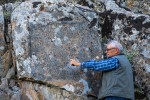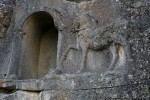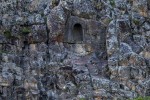 A 2000-year-old tablet inscribed with the rules for horse racing has been discovered in the Beyşehir district of Konya Province, central Anatolia, Turkey. According to Selçuk University history professor Dr. Hasan Bahar, this is the only tablet ever found that details rules of the sport that had a massive following in the Greek, Roman and Byzantine eras. Other sources mention horse racing, but don’t get into the rules.
A 2000-year-old tablet inscribed with the rules for horse racing has been discovered in the Beyşehir district of Konya Province, central Anatolia, Turkey. According to Selçuk University history professor Dr. Hasan Bahar, this is the only tablet ever found that details rules of the sport that had a massive following in the Greek, Roman and Byzantine eras. Other sources mention horse racing, but don’t get into the rules.
“There are horseracing rules on the tablet. It says that if a horse comes in first place in a race it cannot participate in other races, while another horse of the winning horse’s owner also cannot enter another race. In this way, others were given a chance to win. This was a beautiful rule, showing that unlike races in the modern world, races back then were based on gentlemanly conduct,” Bahar also said.
 That may be overstating the case somewhat. Ancient equestrian sports had many of the same features of modern ones — multiple heats and races in a day, careful breeding of horses, publically published bloodlines, on and off-track betting — including scandals like doping and contractual disputes. Both chariot and mounted horse racing were often brutal, resulting in injury and death to horses and drivers/jockeys. Then fandom was very far from gentlemanly as well. Supporters of the four factiones of the chariot race (Reds, Blues, Whites, and Greens) regularly faced off against each other in violent riots. The Nika Riots of 532 A.D. lasted a week, killed tens of thousands and burned half of Constantinople to the ground.
That may be overstating the case somewhat. Ancient equestrian sports had many of the same features of modern ones — multiple heats and races in a day, careful breeding of horses, publically published bloodlines, on and off-track betting — including scandals like doping and contractual disputes. Both chariot and mounted horse racing were often brutal, resulting in injury and death to horses and drivers/jockeys. Then fandom was very far from gentlemanly as well. Supporters of the four factiones of the chariot race (Reds, Blues, Whites, and Greens) regularly faced off against each other in violent riots. The Nika Riots of 532 A.D. lasted a week, killed tens of thousands and burned half of Constantinople to the ground.
 The tablet is part of a monument known as “Horse Rock” to the locals after the relief of a horse carved into the rockface. It was a funerary monument dedicated to Lukuyanus, a beloved jockey who was likely buried in the “grave room”, a small chamber next to the horse relief with a columned entrance. The grave room is devoid of remains now so we don’t know much about Lukuyanus other than what’s on the inscription. It opens: “Lukuyanus The Warrior, Died Before Getting Married. He is Our Hero.”
The tablet is part of a monument known as “Horse Rock” to the locals after the relief of a horse carved into the rockface. It was a funerary monument dedicated to Lukuyanus, a beloved jockey who was likely buried in the “grave room”, a small chamber next to the horse relief with a columned entrance. The grave room is devoid of remains now so we don’t know much about Lukuyanus other than what’s on the inscription. It opens: “Lukuyanus The Warrior, Died Before Getting Married. He is Our Hero.”
Since he died before marriage, he was likely a young man when he met his end, but he lived long enough and had enough success on the track to earn him dedicated fans who built him such a handsome and on-topic final resting place. Fan-funded funerary monuments for sports heroes have proved rich sources of historical information before, thanks to their elaborate inscriptions of victory statistics and laments about referee error leading to death.
 The monument is near the site of an ancient hippodrome in mountains that were sacred to the Hittites. The Romans may even have built a hippodrome on this spot to bless and be blessed by the Hittites’ holy hills.
The monument is near the site of an ancient hippodrome in mountains that were sacred to the Hittites. The Romans may even have built a hippodrome on this spot to bless and be blessed by the Hittites’ holy hills.
Lukuyanus doesn’t sound like the name of a Roman, which the article claims he was. Is it a local language approximation of something like Lucanus?
“Anatolia was contested between the Selucids, the Attalids of Pergamon, the Galatians, invading Celts from Europe”, and -last but not least- Romans, of course.
They should have printed a transcript, and if it said that Lukuyanus was from Rome (instead of e.g. ‘Lycia’), we would possibly have to accept that. As it reads, the aim had been “to honor a jockey named Lukuyanus, who died at an early age in the Pisidia era.”
“Era” ? – “Pisidia (Πισιδία) was a region of ancient Asia Minor located north of Lycia, bordering Caria, Lydia, Phrygia and Pamphylia, and corresponding roughly to the modern-day province of Antalya in Turkey”.
Those, however, are all Greek names, and obviously they wrote in Greek also – Even “hippodrome” (ἱππόδρομος) is a Greek word.
And what about the fact that that area is called KONYA, which in Serbian means KONJ (Horse in English😎😁😁😁😉
Hm, but how does Lukuyanus compare with Leicester City, eh? Answer me that.
The blood lines are what interest me. They clearly had something specific in mind, but what?
Both inscriptions, the one refering to Loukianos (and not… Lukuyanus) and the panel with stipulations concerning games have been published as early as 1888: See Sterrett, John Robert Sitlington. The Wolfe Expedition to Asia Minor (Papers of The American School of Classical Studies at Athens, vol. 3, 1884-1885, Boston 1888) pp. 166-168. (online on https://archive.org/details/papersofamerican03arch).